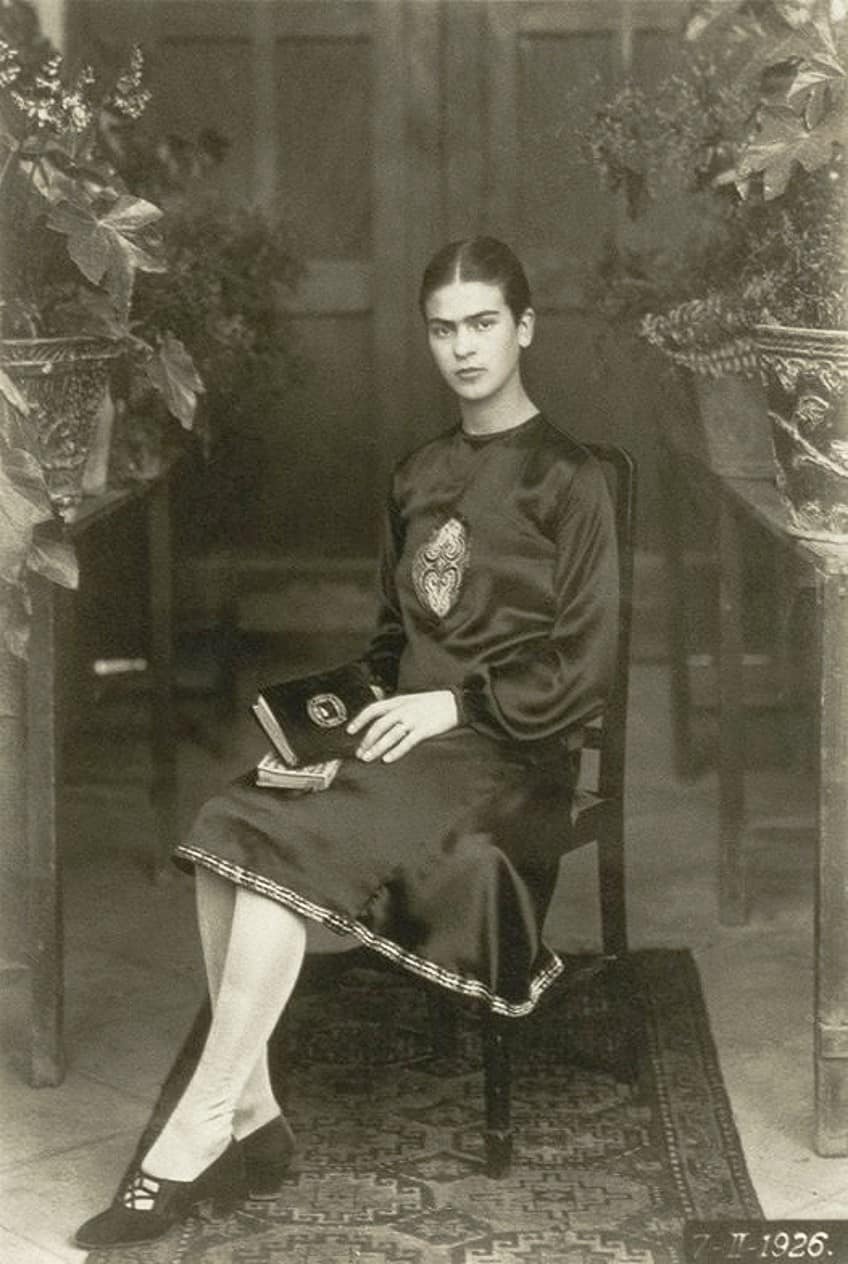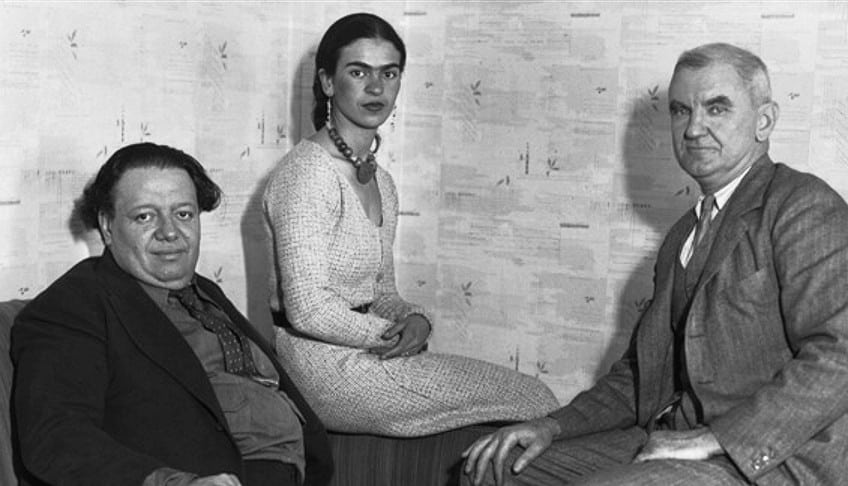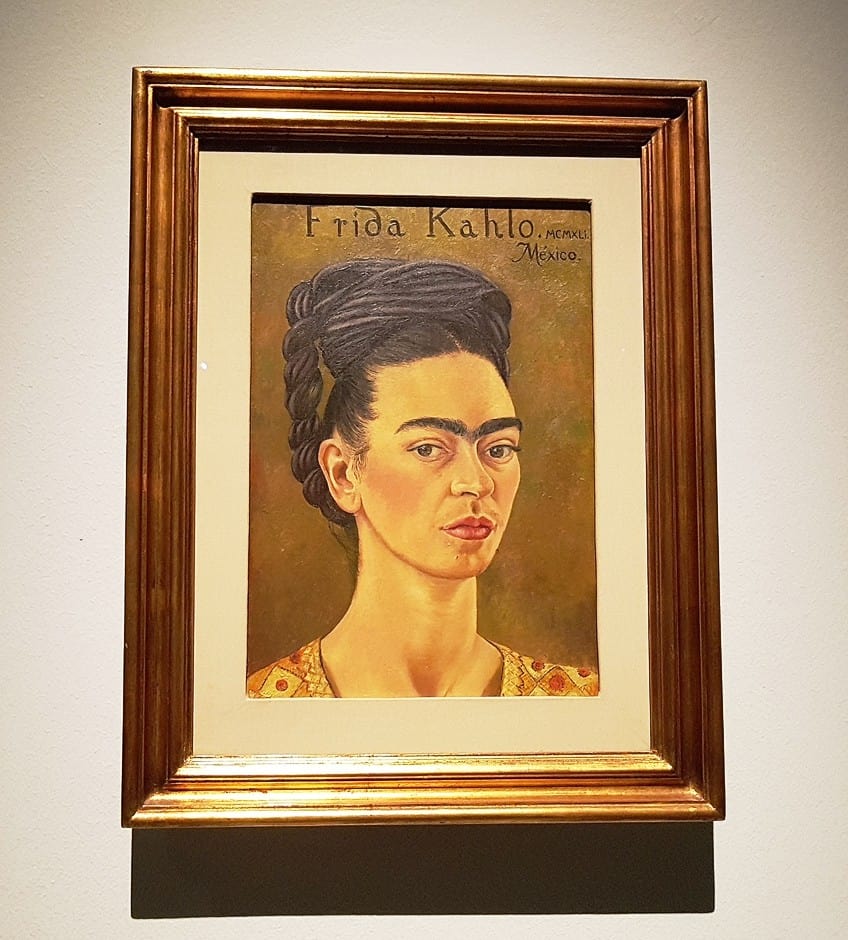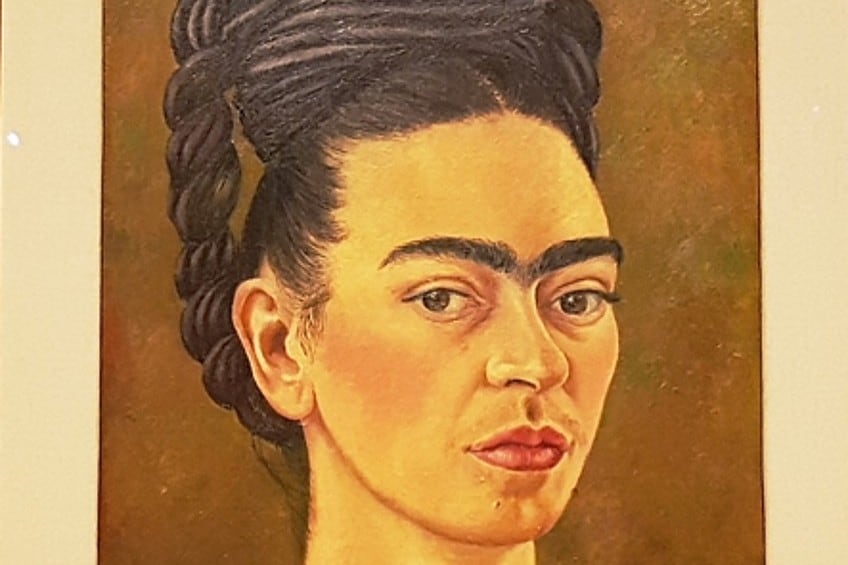“Henry Ford Hospital (The Flying Bed)” by Frida Kahlo – An Analysis
Henry Ford Hospital (The Flying Bed) by Frida Kahlo depicts the artist lying in a hospital bed, with various medical instruments and a fetus floating above her. It is a miscarriage painting that was influenced by Kahlo’s pain about not being able to carry a baby. In this article, we will contextualize the painting within Kahlo’s life, career, and socio-political context and complete a brief visual analysis to understand more about this prolific artist’s work.
Artist Abstract: Who Was Frida Kahlo?
Frida Kahlo (1907 – 1954) was a Mexican painter known for her self-portraits and her depiction of the female experience and form. She was a feminist icon and her work has been celebrated for its honesty, emotion, and use of vibrant colors. Despite being physically disabled due to a bus accident in her youth, Kahlo’s work often depicted her own physical pain and suffering. She was married to the famous muralist Diego Rivera (1886 – 1957), and her work was heavily influenced by Mexican culture and indigenous traditions.
She had a significant impact on the feminist art movement and her paintings are still highly sought after today.

Henry Ford Hospital (The Flying Bed) by Frida Kahlo in Context
| Date | 1932 |
| Medium | Oil on metal |
| Type of Painting | Allegory and self-portrait |
| Movement | Surrealism and Symbolism |
| Dimensions (cm) | 30.5 x 38 |
| Location | The Dolores Olmedo Museum, Mexico City, Mexico |
Kahlo’s life was marked by chronic health problems, including a bus accident in her youth that left her with lifelong injuries and chronic pain. Many of her paintings, including the Henry Ford Hospital painting, depict her own physical pain and suffering and are considered highly personal and intimate. Let us contextualize this miscarriage painting within the life, professional, and socio-political context within which Frida Kahlo created this painting.
Henry Ford Hospital (The Flying Bed) by Frida Kahlo in Context of Kahlo’s Life, Career, and the Mexican Socio-Political Situation
In 1932, Frida Kahlo was pregnant again, which was a dream for her. Despite the doctor’s concerns about her carrying a baby, Kahlo insisted on trying. Despite her dreams, she was anxious about how Diego would react. But Kahlo’s body made the decision and in her third month of pregnancy, she lost the baby.
To help with her grief, Diego (in the same spirit as her father after Kahlo’s bus accident) brought her a set of paints, canvases, and books on anatomy. After her miscarriage, Frida became fascinated by the image of fetuses, which became a symbol in her paintings from then on.
In terms of her career, Kahlo was becoming a prominent artist in Mexico during the 1930s and 1940s. Her work was heavily influenced by Mexican culture and indigenous traditions, and she was a feminist icon. Her paintings were celebrated for their honesty, emotion, and use of vibrant colors.

In terms of the socio-political context of Mexico during the time the painting was created, Mexico was experiencing a period of political and social upheaval. The country was undergoing a process of modernization and industrialization under President Lazaro Cardenas, and artists like Kahlo were responding to this transformation through their art.
The painting also reflects the theme of human suffering, which was a common theme in Mexican muralism, a popular art movement of the time.
Henry Ford Hospital Painting Analysis
In the Henry Ford Hospital painting, Frida Kahlo presents the viewer with a striking self-portrait of herself lying in a hospital bed. Let us look at the compositional overview, subject matter, light and color use, and symbolism Frida Kahlo applied in creating this artwork.
Ex-voto Painting
Frida Kahlo’s painting style, particularly this miscarriage painting, was influenced by the traditional Ex-voto Mexican painting style. Ex-voto, also known as retablos, is a traditional form of Mexican folk art that has its origins in the colonial period. These paintings, which are typically small and made on metal or tin, depict religious or personal events and are used as a form of gratitude or prayer for blessings received or as a petition for future favors.
Ex-voto paintings are often created as a form of devotion to a particular saint or religious figure, and they can be found in churches, shrines, and private homes throughout Mexico.
Ex-voto paintings typically depict a specific event or miracle, such as a recovery from illness or injury, a safe journey, or a successful business venture. The paintings often include a description of the event, a date, and the name of the person for whom the painting was created, as well as the name of the artist.
The images usually include a central figure, such as a saint or the Virgin Mary, as well as other figures and symbols that relate to the event being depicted.
Ex-voto paintings are notable for their vibrant colors and folk art style, which is characterized by strong attention to detail and a lack of perspective. The artists who create these paintings are often self-taught and use a variety of techniques such as painting, drawing, and engraving. These paintings are considered to be sacred and are often treated with great reverence by the people who own them.
Compositional Overview
The composition is dominated by the central figure of the artist, who is lying in a pool of blood on an iron bed, her belly still swollen from the pregnancy. The bed is positioned at the bottom center of the painting but is not in a hospital but outside. In the background of the desolate scene, an industrial cityscape can be seen.
From Kahlo’s left hand, a series of ribbons are connected to various medical instruments, a fetus, a snail, a pelvis, a flower, and an orthopedic cast.
Subject Matter
The subject matter of the painting is deeply personal, as it depicts the artist’s own experiences of physical pain and suffering. The hospital setting and the presence of medical instruments suggest that Kahlo is depicting a specific moment in her life. The fetus floating above the bed is a powerful image that adds an emotional and symbolic layer to the painting. It’s not clear if it’s a representation of a miscarriage.
Color and Light
The color palette used in the painting is primarily cool tones, with the artist’s skin appearing pale and sickly against the white sheets of the hospital bed. The background is mostly cool colors as well. The contrast between the cool colors of the background, the bed, and medical instruments with the symbols floating around the bed and the blood on the sheets creates a sense of drama and shock.
Texture
The texture in the painting is predominantly smooth and flat, with the exception of the object floating around Kahlo, which has a more detailed and realistic texture. The artist’s skin, meanwhile, appears almost translucent, adding to the sense of fragility and vulnerability.
Symbolism
The painting is rich in symbolism, the fetus floating in the air can be interpreted as a representation of the artist’s own pain and suffering, while the medical instruments scattered around the bed symbolize the physical and emotional trauma that she has experienced. The dark background, the fetus, and the artist’s gaze all contribute to creating a mood of isolation and despair.

Overall, Henry Ford Hospital (The Flying Bed) by Frida Kahlo is a powerful and deeply personal work that provides a window into the artist’s own experiences of physical pain and emotional turmoil. This miscarriage painting shows a different aspect of her physical and emotional pain, and shows elements of the traditional Ex-voto style. It illustrates why Kahlo’s emotional paintings evoke compassion in the viewer and is regarded as powerful still to this day.
Frequently Asked Questions
Why Did Frida Kahlo Create Paintings of Her Pain?
Frida Kahlo’s (1907 – 1954) life was marked by chronic pain, and it has been suggested that this led her to enjoy the attention it brought her. This theory can be seen illustrated in her painting, The Broken Column (1944), where she depicted both her pain and her sensuality. However, other works such as Without Hope (1945) suggest that her relationship with pain was not just for attention. After her death, it was determined that her physical struggles were caused by a congenital spinal issue. Given this information and her behavior when in pain, such as only agreeing to treatment with her sister by her side and the songs her husband sang to her in the hospital, it is possible that Kahlo’s relationship with pain was influenced not only by her medical condition, but also by her childhood experiences of abandonment by her mother who suffered from depression.
How Many Miscarriages Did Frida Kahlo Go Through?
It is believed that Frida Kahlo (1907 – 1954) had multiple miscarriages throughout her life. However, the exact number of miscarriages that she had is not confirmed as there are no official records. In her painting, Henry Ford Hospital (The Flying Bed) (1932), it is thought that she depicted a miscarriage. In her diary, Kahlo wrote extensively about her struggles with infertility and her desire to have children. She also wrote about her physical and emotional pain related to her miscarriages, which suggests that she had multiple throughout her life.
Nicolene Burger, a South African multimedia artist and creative consultant, specializes in oil painting and performance art. She earned her BA in Visual Arts from Stellenbosch University in 2017. Nicolene’s artistic journey includes exhibitions in South Korea, participation in the 2019 ICA Live Art Workshop, and solo exhibitions. She is currently pursuing a practice-based master’s degree in theater and performance. Nicolene focuses on fostering sustainable creative practices and offers coaching sessions for fellow artists, emphasizing the profound communicative power of art for healing and connection. Nicolene writes blog posts on art history for artfilemagazine with a focus on famous artists and contemporary art.
Learn more about Nicolene Burger and about us.
Cite this Article
Nicolene, Burger, ““Henry Ford Hospital (The Flying Bed)” by Frida Kahlo – An Analysis.” artfilemagazine – Your Online Art Source. March 31, 2023. URL: https://artfilemagazine.com/henry-ford-hospital-the-flying-bed-by-frida-kahlo/
Burger, N. (2023, 31 March). “Henry Ford Hospital (The Flying Bed)” by Frida Kahlo – An Analysis. artfilemagazine – Your Online Art Source. https://artfilemagazine.com/henry-ford-hospital-the-flying-bed-by-frida-kahlo/
Burger, Nicolene. ““Henry Ford Hospital (The Flying Bed)” by Frida Kahlo – An Analysis.” artfilemagazine – Your Online Art Source, March 31, 2023. https://artfilemagazine.com/henry-ford-hospital-the-flying-bed-by-frida-kahlo/.



